

2024
Lofgren L, Nguyen NH, Kennedy PG, Pérez-Pazos E, Fletcher J, Liao H-L, Wang H, Zhang K, Ruytinx J, Smith AH, Ke Y-H, Cotter HVT, Engwall E, Hameed K, Vilgalys R, Branco S. (2024). Suillus: an emerging model for the study of ectomycorrhizal ecology and evolution. New Phytologist. doi: 10.1111/nph.19700

 Ectomycorrhizal fungi are essential symbionts of many northern hemisphere forests. While much is known about their association in terms of nutrient exchange, it has been difficult to focus on the mechanism of association due to the thousands of species of ectomycorrhizal species that exists.
In the last decade, the International Suillus Consortium has produced resources from protocols to genomes that allows us to build the genus Suillus into a powerful model system for ecology and evolution.
In this paper, we reviewed on the current state of knowledge of the biology of this genus mostly within the last 10 years, and identified the many areas of interest that is currently being studied. The paper provides resources that could be used for research in the field.
Ectomycorrhizal fungi are essential symbionts of many northern hemisphere forests. While much is known about their association in terms of nutrient exchange, it has been difficult to focus on the mechanism of association due to the thousands of species of ectomycorrhizal species that exists.
In the last decade, the International Suillus Consortium has produced resources from protocols to genomes that allows us to build the genus Suillus into a powerful model system for ecology and evolution.
In this paper, we reviewed on the current state of knowledge of the biology of this genus mostly within the last 10 years, and identified the many areas of interest that is currently being studied. The paper provides resources that could be used for research in the field.
Lewis RW, Bittenbender HC, *Heisey HC, Nguyen NH. Phyllosphere to ferment: Site conditions structures cacao pod and ferment microbiomes in Hawai‘i. PhytoFrontiers. doi.org/10.1094/PHYTOFR-08-23-0104-R

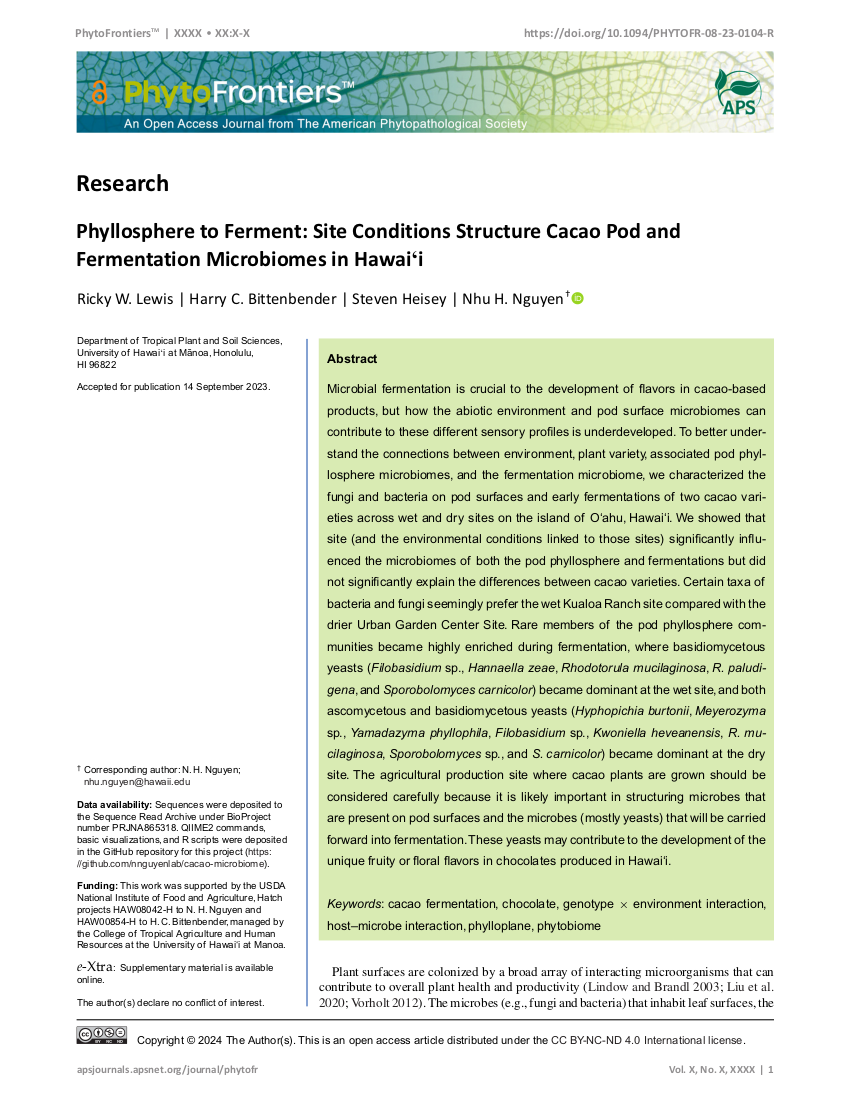 The natural flavors of cacao, and thus chocolates, appear to be connected to the variety of the plant, origins of where the plants are grown, and where the beans are processed.
In this paper, we studied how surface microbes on cacao plants (phyllosphere microbes) may participate in fermentation of cacao beans. Are there different microbes on different varieties? Does it matter where the plants are grown? And can these microbes contribute to development of unique flavors during fermentation?
To answer these questions, we sampled the microbiome of cacao pods of two varieties at wet and dry locations on the island of O‘ahu, Hawai‘i. We identified the fungi and bacteria on the pod surfaces, as well as those in the fermentation.
We found that the fermentation process selected for certain microbes that existed in minute proportions on the pod surface. The varieties didn't matter as much as where the plants are grown. This in turn does seem to have some connections to the "fruity" flavors of chocolates grown and processed in Hawai‘i, although that evidence is limited.
This work provides the first DNA characterization of the microbes that live on cacao pod surfaces and in fermentations in Hawai‘i, and points to some important clues to help guide how we grow and produce uniquely flavored chocolates and preserve the "terroir" of the cacao grown and processed Hawai‘i, and potentially elsewhere.
The natural flavors of cacao, and thus chocolates, appear to be connected to the variety of the plant, origins of where the plants are grown, and where the beans are processed.
In this paper, we studied how surface microbes on cacao plants (phyllosphere microbes) may participate in fermentation of cacao beans. Are there different microbes on different varieties? Does it matter where the plants are grown? And can these microbes contribute to development of unique flavors during fermentation?
To answer these questions, we sampled the microbiome of cacao pods of two varieties at wet and dry locations on the island of O‘ahu, Hawai‘i. We identified the fungi and bacteria on the pod surfaces, as well as those in the fermentation.
We found that the fermentation process selected for certain microbes that existed in minute proportions on the pod surface. The varieties didn't matter as much as where the plants are grown. This in turn does seem to have some connections to the "fruity" flavors of chocolates grown and processed in Hawai‘i, although that evidence is limited.
This work provides the first DNA characterization of the microbes that live on cacao pod surfaces and in fermentations in Hawai‘i, and points to some important clues to help guide how we grow and produce uniquely flavored chocolates and preserve the "terroir" of the cacao grown and processed Hawai‘i, and potentially elsewhere.
2023
**Abe JNA, Dhungana I, Nguyen NH. (2023). Legume-nodulating rhizobia are widespread in soils and plants across the island of O‘ahu, Hawai‘i. PLOS ONE 18(9): e0291250. doi: 10.1371/journal.pone.0291250

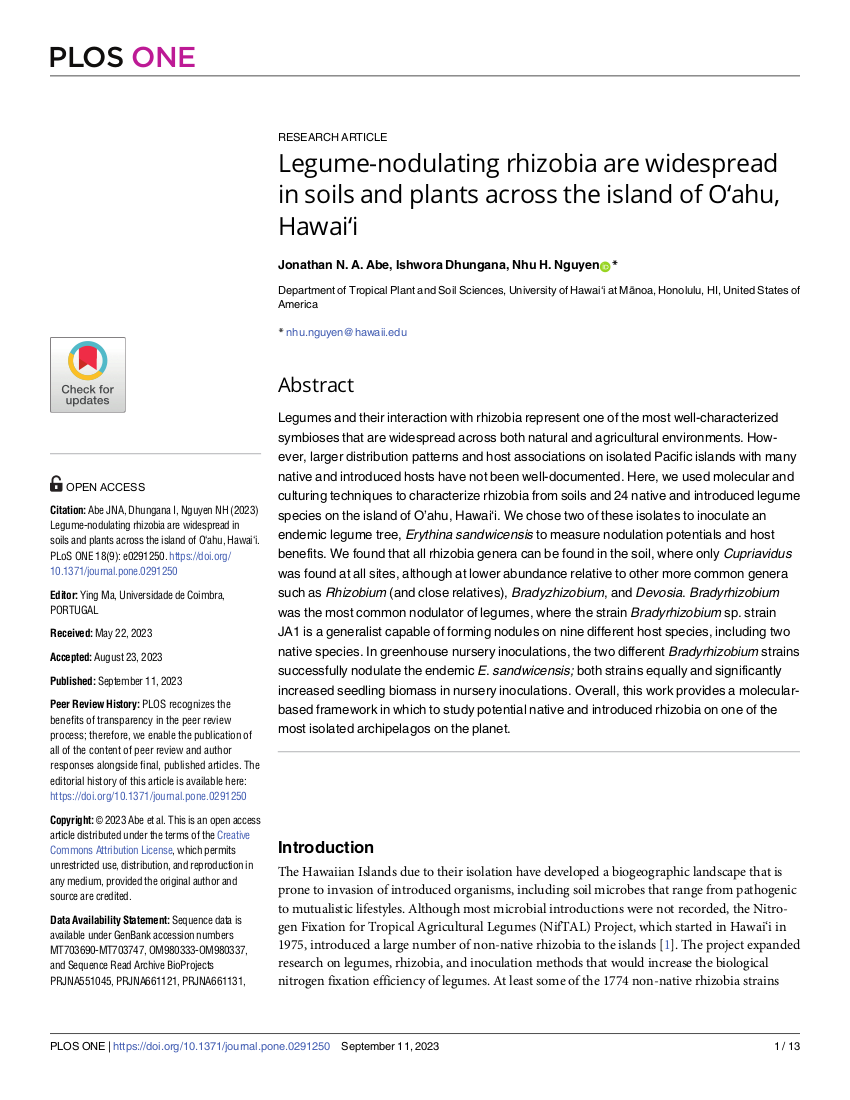 Rhizobia are plant-nodulating bacteria that associates with the roots of leguminous (beans/pulse) plants. These bacteria fix nitrogen, and thus proper use can drastically reduce mineral fertilizers and contribute to sustainable and regenerative agriculture.
From the 1970's to the 1990's, the Nitrogen Fixation for Tropical Agricultural Legumes (NifTAL) project introduced a large number of rhizobia to Hawai‘i. It is likely that these rhizobia still exist in our soils until today, although there has been no molecular inventory of these microbes.
In this paper, led by undergraduate researcher Jon Abe, we sampled the root nodules associated with a number of leguminous plants around the island of O‘ahu. Then we isolated and sequenced the DNA of those bacteria. We also sampled a large number of soils and identified the rhizobia from those soils.
We found that all genera of plant-nodulating rhizobia exists on O‘ahu(!), but their distribution is different based on location. Only Cupriavidus is common across all soils (including undisturbed and isolated areas), potentially making members of this genus a native to O‘ahu.
This work showed that we generally have inoculants in the soil, and farmers in general do not need to provide additional inoculants to their soils when planting legumes.
Rhizobia are plant-nodulating bacteria that associates with the roots of leguminous (beans/pulse) plants. These bacteria fix nitrogen, and thus proper use can drastically reduce mineral fertilizers and contribute to sustainable and regenerative agriculture.
From the 1970's to the 1990's, the Nitrogen Fixation for Tropical Agricultural Legumes (NifTAL) project introduced a large number of rhizobia to Hawai‘i. It is likely that these rhizobia still exist in our soils until today, although there has been no molecular inventory of these microbes.
In this paper, led by undergraduate researcher Jon Abe, we sampled the root nodules associated with a number of leguminous plants around the island of O‘ahu. Then we isolated and sequenced the DNA of those bacteria. We also sampled a large number of soils and identified the rhizobia from those soils.
We found that all genera of plant-nodulating rhizobia exists on O‘ahu(!), but their distribution is different based on location. Only Cupriavidus is common across all soils (including undisturbed and isolated areas), potentially making members of this genus a native to O‘ahu.
This work showed that we generally have inoculants in the soil, and farmers in general do not need to provide additional inoculants to their soils when planting legumes.
Wilson AW, Eberhardt U, Nguyen NH, *Noffsinger C, Swenie R, Loucks JJ, Perry BA, Hererra M, Osmundson T, Duhon-Delong S, Beker HJ, Mueller GM. (2023). Does one size fit all? Variation in the DNA barcode gap of macrofungal genera. Journal of Fungi, 9, 788. doi: 10.3390/jof9080788

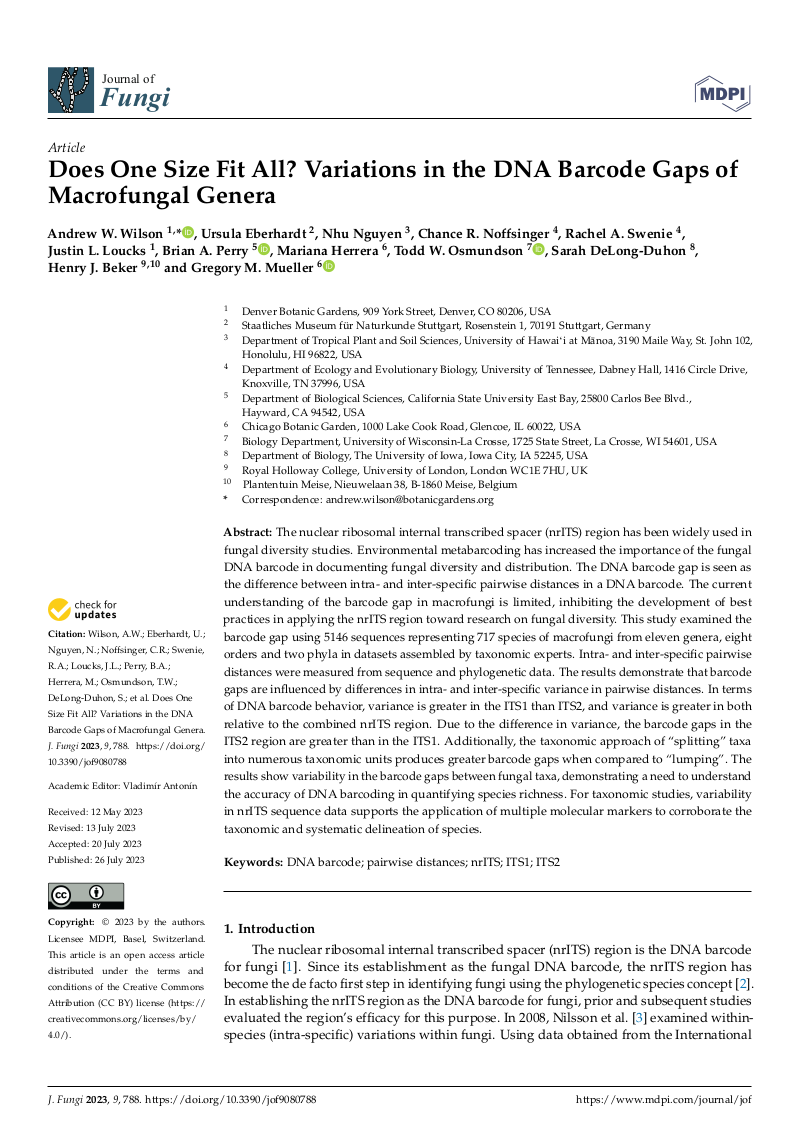 Using DNA as a molecular marker to identify fungal (and other groups) species has transformed our understanding of fungal biodiversity.
However, there are still issues in using this method, in particular, how do we choose the right proportion of nucleotide differences between two DNA sequences to tell whether they belong the same species?
This paper examines the variation in nucleotide differences of the Internal Transcribed Spacer (ITS) rRNA gene, universal marker for Fungi. We compared these differences within species and across species.
We found that certain species have large differences whereas other species do not. In general, the ITS2 region of the gene would generally be better for species identification.
These findings adds some insights into how we may better use these DNA regions for taxonomic and ecological studies, which are on opposite ends of the spectrum in terms of how we apply DNA molecular markers.
Using DNA as a molecular marker to identify fungal (and other groups) species has transformed our understanding of fungal biodiversity.
However, there are still issues in using this method, in particular, how do we choose the right proportion of nucleotide differences between two DNA sequences to tell whether they belong the same species?
This paper examines the variation in nucleotide differences of the Internal Transcribed Spacer (ITS) rRNA gene, universal marker for Fungi. We compared these differences within species and across species.
We found that certain species have large differences whereas other species do not. In general, the ITS2 region of the gene would generally be better for species identification.
These findings adds some insights into how we may better use these DNA regions for taxonomic and ecological studies, which are on opposite ends of the spectrum in terms of how we apply DNA molecular markers.
Ke Y-H, Branco S, Bazzicalupo AL, Nguyen NH, Liao HL, Kennedy P, Bruns TD, Kuo A, LaButti K, Barry K, Grigoriev I, Vilgalys R. (2023). Genomic determination of breeding systems in basidiomycete fungi: direct evidence for balancing selection and trans-specific evolution of HD MAT genes between sister genera of suilloid fungi. Genetics, Apr 18:iyad069. doi: 10.1093/genetics/iyad069

 Fungi, such as those of Suillus in this study, can have many mating types, but it's often not very clear how these mating types are structured in fungi and what controls the mating system as a whole.
In other words, what makes them self or non-self compatible and if they can mate with other fungi. As in all biological organisms, being able to self or not can determine the fitness of survival.
In this study, we use the large number of genomes of mushrooms in the genus Suillus and the false truffle Rhizopogon to understand how their mating system is structured.
We found that Suillus indeed have evolved incompatibility from each other as well as there in compatibility within themselves. This means that at least for Suillus, selfing isn't a common option and outbreeding/crossing with other strains is likely the choice.
Understanding how these mating types are structured within Suillus allows us to delve deeper into the biology of these important ectomycorrhizal fungi.
Fungi, such as those of Suillus in this study, can have many mating types, but it's often not very clear how these mating types are structured in fungi and what controls the mating system as a whole.
In other words, what makes them self or non-self compatible and if they can mate with other fungi. As in all biological organisms, being able to self or not can determine the fitness of survival.
In this study, we use the large number of genomes of mushrooms in the genus Suillus and the false truffle Rhizopogon to understand how their mating system is structured.
We found that Suillus indeed have evolved incompatibility from each other as well as there in compatibility within themselves. This means that at least for Suillus, selfing isn't a common option and outbreeding/crossing with other strains is likely the choice.
Understanding how these mating types are structured within Suillus allows us to delve deeper into the biology of these important ectomycorrhizal fungi.
Nguyen NH. (2023). Fungal hyphosphere microbiomes are distinct from surrounding substrates and show consistent association patterns. Microbiology Spectrum, 11:2, e04708-22. doi: 10.1128/spectrum.04708-22

 Fungal-bacterial interactions are everywhere. Our lab spent the last few years studying the interactions between fungi and bacteria and the consequences of their interactions. We think that these ubiquitous interactions can have major consequences on ecosystem processes and outcomes.
This paper started as the last chapter of my (Nhu's) PhD dissertation. I studied a growth form of fungi called "mats", where the mycelium grows thickly into white mycelial mats in the soil. I wondered what type of bacteria might be inhabiting these mats and how do they compare to the bacteria immediately outside of the mats.
Back then, 454 pyrosequencing came online and quickly phased out so the DNA sequence data that I collected is no longer any good. It took a decade for me to catch up and re-sequence those samples using the more stable Illumina platform that generated many more quality sequences.
The DNA sequencing results allowed me to distinguish between the bacteria within and outside of the mats, as well as identify specific taxa that are associated with these mats.
Diving deeper into the literature, I found that a number of bacteria genera seem to have been found consistently within fungal mats across the world. This indicates that fungal-bacterial interactions does have some specificity, a major finding of this paper. This finding provides us with important clues to build research questions centering around fungal-bacterial interactions in the future.
Fungal-bacterial interactions are everywhere. Our lab spent the last few years studying the interactions between fungi and bacteria and the consequences of their interactions. We think that these ubiquitous interactions can have major consequences on ecosystem processes and outcomes.
This paper started as the last chapter of my (Nhu's) PhD dissertation. I studied a growth form of fungi called "mats", where the mycelium grows thickly into white mycelial mats in the soil. I wondered what type of bacteria might be inhabiting these mats and how do they compare to the bacteria immediately outside of the mats.
Back then, 454 pyrosequencing came online and quickly phased out so the DNA sequence data that I collected is no longer any good. It took a decade for me to catch up and re-sequence those samples using the more stable Illumina platform that generated many more quality sequences.
The DNA sequencing results allowed me to distinguish between the bacteria within and outside of the mats, as well as identify specific taxa that are associated with these mats.
Diving deeper into the literature, I found that a number of bacteria genera seem to have been found consistently within fungal mats across the world. This indicates that fungal-bacterial interactions does have some specificity, a major finding of this paper. This finding provides us with important clues to build research questions centering around fungal-bacterial interactions in the future.
Shemesh H, Bruns TD, Peay KG, Kennedy PG, Nguyen NH. (2023). Changing balance between dormancy and mortality determines trajectory of ectomycorrhizal fungal spore longevity over a 15 year burial experiment. New Phytologist, 238:11–15. doi: 10.1111/nph.18677

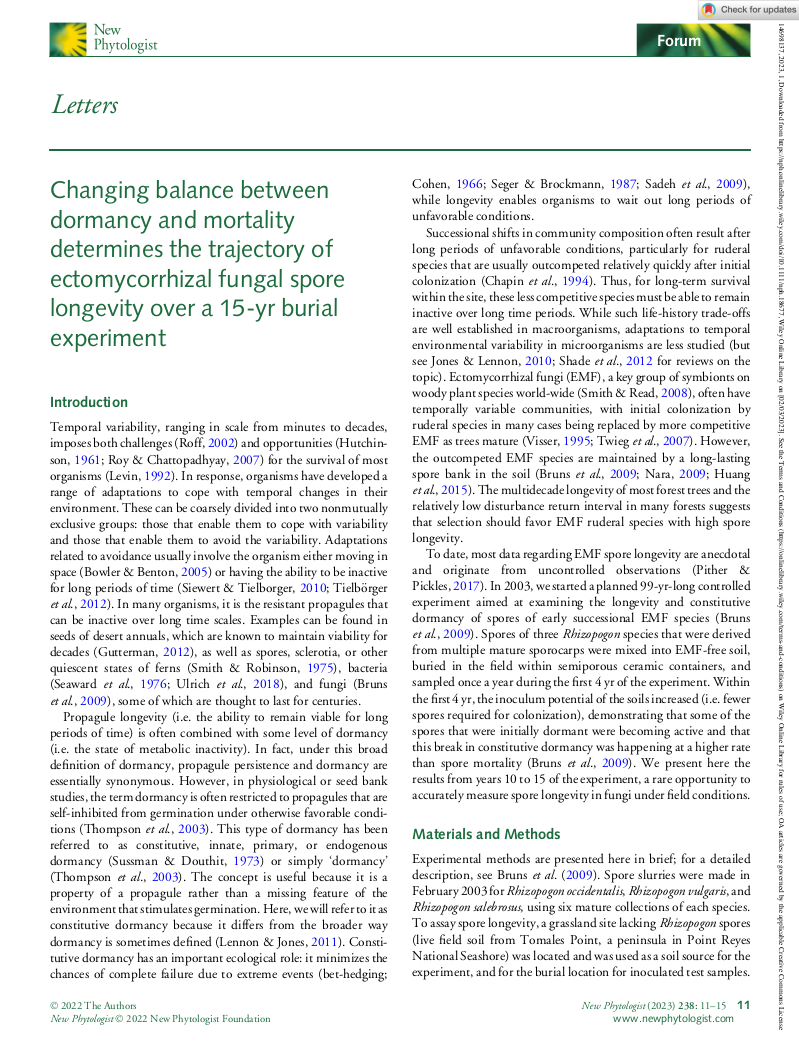 How long do fungal spores last? That simple question, as it turns out, takes a lot of effort to answer because to answer how long something remains viable, or its longevity, requires an investment of time. This investment is often in terms of years or decades.
In this paper, we reported the spore longevity of three ectomycorrhizal false truffle species in the genus Rhizopogon. We collected and buried the spores in soil and retrieved them periodically to measure their viability.
The pattern of viability was strange — the spores seemed to be less viable at first, becoming more viable over time, then returning to the initial state after 15 years. To make sense of this finding, we must interpret this patterns through the concept of dormancy.
Spores are the propagule of fungi, and much like seeds, can have dormancies to weather out adverse environmental conditions. In the case of ectomycorrhizal fungi such as Rhizopogon, the spores lie and wait for a new host seedling to grow.
From this study, we now know that most Rhizopogon spores start out dormant, then they break that dormancy over time, followed by slow decay of their viability. We set up this experiment for 99 years, so stay tuned.
How long do fungal spores last? That simple question, as it turns out, takes a lot of effort to answer because to answer how long something remains viable, or its longevity, requires an investment of time. This investment is often in terms of years or decades.
In this paper, we reported the spore longevity of three ectomycorrhizal false truffle species in the genus Rhizopogon. We collected and buried the spores in soil and retrieved them periodically to measure their viability.
The pattern of viability was strange — the spores seemed to be less viable at first, becoming more viable over time, then returning to the initial state after 15 years. To make sense of this finding, we must interpret this patterns through the concept of dormancy.
Spores are the propagule of fungi, and much like seeds, can have dormancies to weather out adverse environmental conditions. In the case of ectomycorrhizal fungi such as Rhizopogon, the spores lie and wait for a new host seedling to grow.
From this study, we now know that most Rhizopogon spores start out dormant, then they break that dormancy over time, followed by slow decay of their viability. We set up this experiment for 99 years, so stay tuned.
*Dhungana I, Kantar MB, Nguyen NH. (2023). Root exudate quality from different plant species influences the growth of rhizosphere bacteria. Rhizosphere, 25:100645. doi: 10.1016/j.rhisph.2022.100645

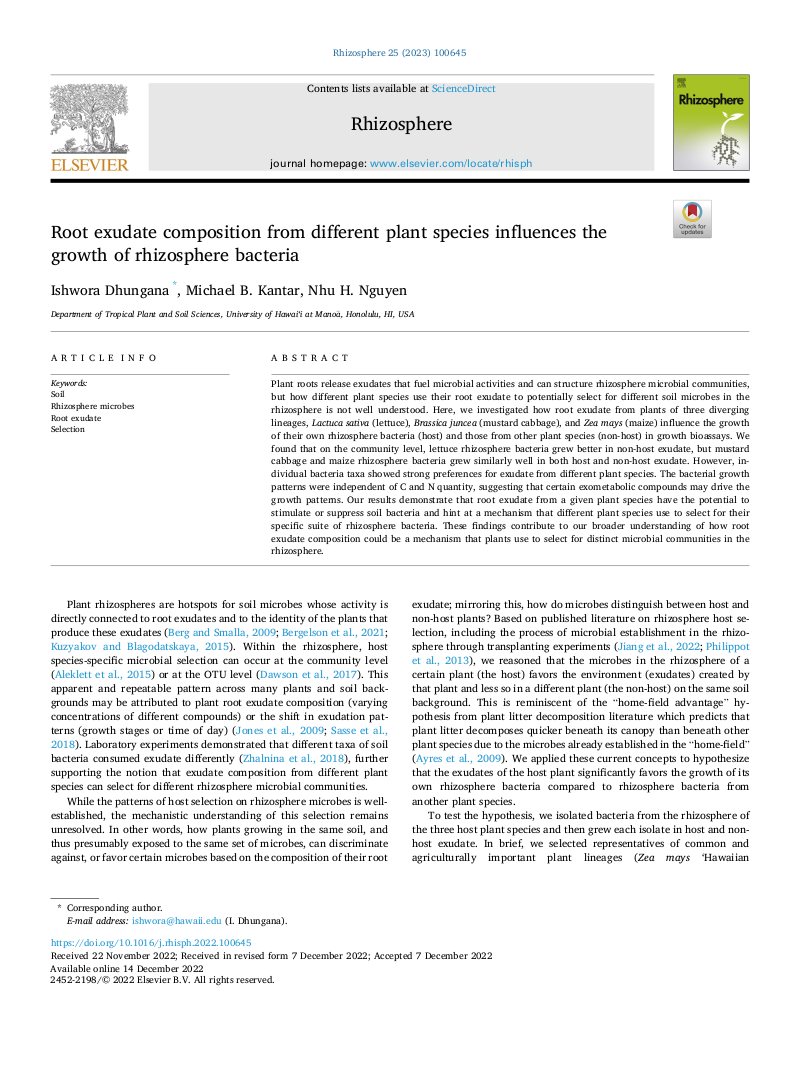 The rhizosphere, the areas directly influenced by plant roots, is a currently active topic of research around the world. Its interactions with soil microbes can guide us to achieve sustainable agriculture.
Plant roots release compounds to the rhizosphere that feed certain types of bacteria and appears to have some selective properties for these bacteria. We wondered whether different species of plants, and thus presumably different root exudates, can select for different bacteria?
We extracted the root exudates from three representatives of crop plants, lettuce (Asteraceae), mustard cabbage (Brassicaceae), and maize (Poaceae). We then isolated bacteria from the roots of these plants, reciprocally grew these bacteria in these root exudates, and measured their growth response.
We found signals of selection, either positive or negative, but these were idiosyncratic for different bacterial species. The growth pattern was independent of C & N quantity in the medium, suggesting that some other molecule(s) is controlling the growth of these bacteria.
Overall, this study showed that plants can perhaps use specific molecules to encourage or suppress bacteria in their rhizospheres. This can lead to developing plant varieties that secrete specific compounds to encourage beneficial bacteria for plant growth and productivity.
The rhizosphere, the areas directly influenced by plant roots, is a currently active topic of research around the world. Its interactions with soil microbes can guide us to achieve sustainable agriculture.
Plant roots release compounds to the rhizosphere that feed certain types of bacteria and appears to have some selective properties for these bacteria. We wondered whether different species of plants, and thus presumably different root exudates, can select for different bacteria?
We extracted the root exudates from three representatives of crop plants, lettuce (Asteraceae), mustard cabbage (Brassicaceae), and maize (Poaceae). We then isolated bacteria from the roots of these plants, reciprocally grew these bacteria in these root exudates, and measured their growth response.
We found signals of selection, either positive or negative, but these were idiosyncratic for different bacterial species. The growth pattern was independent of C & N quantity in the medium, suggesting that some other molecule(s) is controlling the growth of these bacteria.
Overall, this study showed that plants can perhaps use specific molecules to encourage or suppress bacteria in their rhizospheres. This can lead to developing plant varieties that secrete specific compounds to encourage beneficial bacteria for plant growth and productivity.
2022
*McGrath CR, Hicks Pries CE, Nguyen NH, Glazer B, Lio S, Crow SE. (2022). Minerals limit the deep soil respiration response to warming in a tropical Andisol. Biogeochemistry. In press. https://doi.org/10.1007/s10533-022-00965-1. Paper
Amend AS, et al. (2022). A ridge-to-reef ecosystem microbial census reveals environmental reservoirs for animal and plant microbiomes. Proceedings of the National Academy of Sciences, 119:e2204146119. DOI: 10.1073/pnas.2204146119. Paper
Plakidas JD, Nguyen NH, Ferro ML. (2022). A new species of Neostenoptera Meunier (Diptera: Cecidomyiidae: Winnertziinae) from Hawai‘i. Insecta Mundi 941: 1–12. Paper
*Heisey S, Ryals R, Maaz MT, Nguyen NH. (2022). A single application of compost can leave lasting impacts on soil microbial community structure and alter cross-domain interaction networks. Frontiers in Soil Science, 2:749212. DOI: 10.3389/fsoil.2022.749212. Paper
Erlandson S, Margis R, Ramirez A, Nguyen NH, Lofgren L, Liao H-L, Vilgalys R, Kennedy P, Peay K. (2022). Transcriptional acclimation and spatial differentiation characterize drought response by the ectomycorrhizal fungus Suillus pungens. New Phytologist, 234:1910–1913. DOI: 10.1111/nph.17816. Paper
Maaz MT, Nguyen NH, Del Valle Echevarria A, Kantar M, Mileyko Y, Muszynski M. (2022). Design and implementation of a cohort-based undergraduate research experience in the agricultural sciences. Natural Sciences Education, 51, e20076. DOI: 10.1002/nse2.20076. Paper
2021
Nuccio EE, Nguyen NH, Nunes da Rocha U, Mayali X, Weber P, Brodie E, Firestone M. (2021). Community RNA-Seq: Multi-kingdom responses to living versus decaying root inputs in soil. ISME Communications 1, 72. doi:10.1038/s43705-021-00059-3. Paper
Bazzicalupo AL, Erlandson S, Branine M, Ratz M, Ruffing L, Nguyen NH, Branco S. (2021). Fungal community shift along steep environmental gradients from geothermal soils in Yellowstone National Park. Microbial Ecology, DOI:10.1007/s00248-021-01848-y. Paper
*Perez-Pazos E, Certano A, **Gagne J, Lebeuf R, Siegel N, Nguyen NH, Peter Kennedy. (2021). The slippery nature of ectomycorrhizal host specificity: Suillus fungi associated with novel pinoid (Picea) and abietoid (Abies) hosts. Mycologia, DOI: 10.1080/00275514.2021.1921525. Paper
*Jamison J, Khanal SK, Nguyen NH, Deenik JL. (2021). Assessing the effects of digestates and combinations of digestates and fertilizer on yield and nutrient use of Brassica juncea (Kai Choy). Agronomy 11:509. DOI: 10.3390/agronomy11030509. Paper
Yuan M, *Kakouridis A, *Starr E, Nguyen NH, Shi S, Pett-Ridge J, Nuccio E, Zhou J, and Firestone M. (2021). Fungal-bacterial co-occurrence patterns differ between AMF and non-mycorrhizal fungi across soil niches. mBio 12:e03509-20. DOI: 10.1128/mBio.03509-20. Paper
Lofgren L, Nguyen NH, Vilgalys R, Ruytinx J, Liao H-L, Branco S, Kuo A, LaButti K, Lipzen Anna, Andreopoulos W, Pangilinan J, Riley R, Hundley H, Na H, Barry K, Grigoriev I, Stajich J, Kennedy P. (2021). Comparative genomics reveals dynamic genome evolution in host specialist ectomycorrhizal fungi. New Phytologist 230:774-792. DOI: 10.1111/nph.17160 Paper
Põlme, S., Abarenkov, K., Henrik Nilsson, R., Lindahl, B. D., Clemmensen, K. E., Kauserud, H., … Tedersoo, L. (2021). FungalTraits: a user-friendly traits database of fungi and fungus-like stramenopiles. Fungal Diversity 105:1-16. DOI: 10.1007/s13225-020-00466-2. Paper
2020
Bazzicalupo A, Ruytinx J, Ke Y-H, Coninx L, Colpaert J, Nguyen NH, Vilgalys R, Branco S. (2020). Fungal heavy metal adaptation through single nucleotide polymorphisms and copy-number variation. Molecular Ecology 29:4157-4169. DOI:10.1111/mec.15618. Paper
Kennedy P, **Gagne J, *Pérez PE, Lofgren LA, Nguyen NH. 2020. Does fungal competitive ability explain host specificity or rarity in ectomycorrhizal symbioses? PLoS ONE, 15:e0234099. DOI: 10.1371/journal.pone.0234099. Paper
2019
Bruns TD, Hale LM, Nguyen NH. (2019). Rhizopogon olivaceotinctus increases its inoculum potential in heated soil independent of competitive release from other ectomycorrhizal fungi. Mycologia 111:936-941. DOI: 10.1080/00275514.2019.1657354. Paper
*Wehr NH, Kinney MK, Nguyen NH, Giardina CP, Litton CM. (2019). Changes in soil bacterial community diversity following the removal of invasive feral pigs from a Hawaiian tropical montane wet forest. Scientific Reports, Scientific Reports 9:14681. DOI: 10.1038/s41598-019-48922-7. Paper
2018
Lofgren L, Nguyen NH, Kennedy P. (2018). Ectomycorrhizal host specificity in a changing world: can legacy effects explain anomalous current associations? New Phytologist, 220:1273-1284. DOI: 10.1111/nph.15008. Paper
Nguyen NH. (2018). Longevity of light and dark-colored basidiospores from saprotrophic mushroom-forming fungi. Mycologia 110:131-135. DOI: 10.1111/nph.15008. Paper
Hynson NA, Frank KL, Alegado RA, Amend AS, Arif M, Bennett GM, Jani AJ, Medeiros MCI, Mileyko Y, Nelson CE, Nguyen NH, Nigro OD, Prisic S, Shin S, Takagi D, Wilson ST, Yew JY. (2018). Synergy among microbiota and their hosts: Leveraging the Hawaiian archipelago and local collaborative networks to address pressing questions in microbiome research. mSystems 3:e00159-1. DOI: 10.1128/mSystems.00159-17. Paper
Kennedy P, Louis Mielke*, Nguyen NH. (2018). Ecological responses to forest age, habitat, and host vary by mycorrhizal type in boreal peatlands. Mycorrhiza 28:315-328, doi: 10.1007/s00572-018-0821-4. Paper
2017
Branco S, Bi K, Liao H-L, Gladieux P, Badouin H, Ellison CE, Nguyen NH, Vilgalys R, Peay KG, Taylor JW, Bruns TD. (2017). Continental-level population differentiation and environmental adaptation in the mushroom Suillus brevipes. Molecular Ecology. Molecular Ecology 26:2063–2076. doi: 10.1111/mec.13892

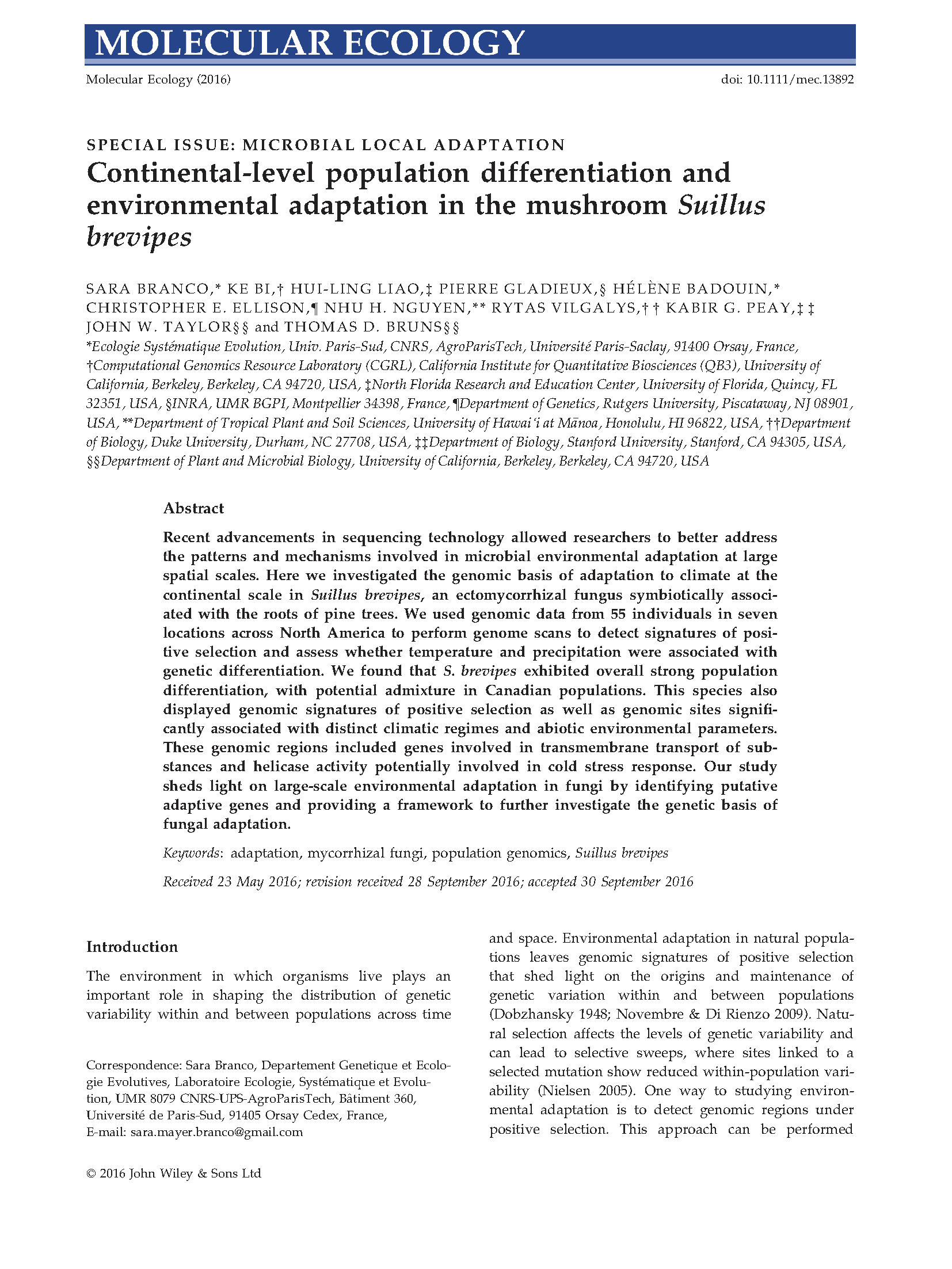
Fernandez C, Nguyen NH, Stefanski A, Han Y, Hobbie S, Montgomery R, Reich PB, Kennedy P. 2017. Reduced boreal tree host photosynthetic performance in response to warming selectively alters ectomycorrhizal fungal community structure. Global Change Biology 23:1598–1609. doi: 10.1111/gcb.13510

 text here...
text here...
2016
Nguyen NH, Vellinga EC, Bruns TD, Kennedy PG. (2016). Phylogenetic assessment of global Suillus ITS sequences supports morphologically defined species and reveals synonymous and undescribed taxa. Mycologia 108:1216-1228. doi: 10.3852/16-106

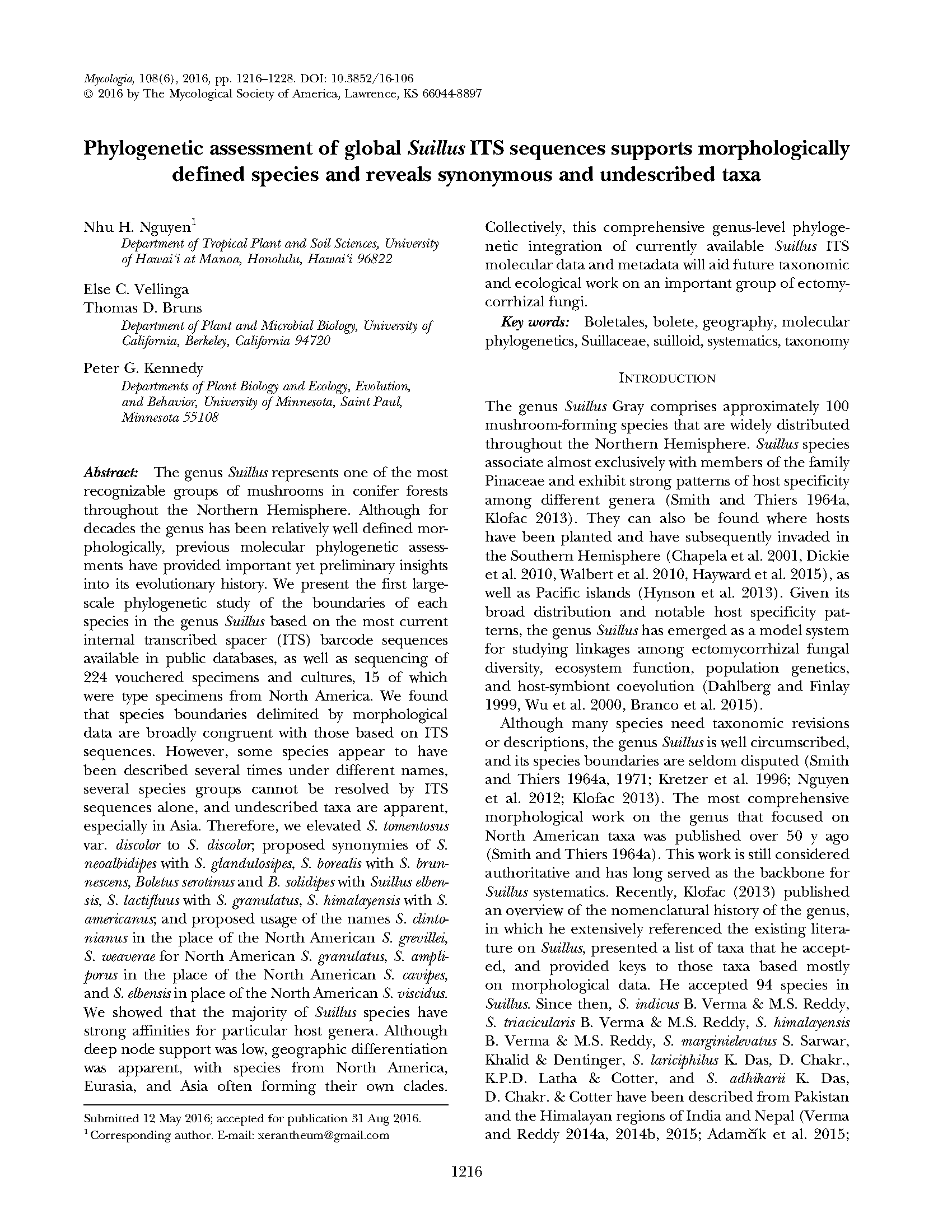 text here...
text here...
Prior to 2016
Papers published before August 2016 are not included on this page because the work was performed outside of the University of Hawai‘i. They can be found on Nhu's page.